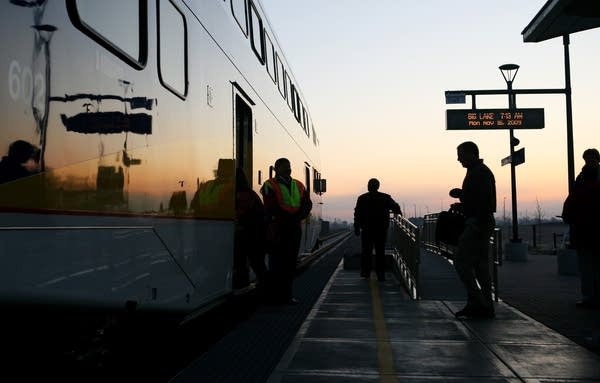MnDOT releases $9 billion rail plan
Go Deeper.
Create an account or log in to save stories.
Like this?
Thanks for liking this story! We have added it to a list of your favorite stories.

The Minnesota Department of Transportation released a long-awaited state rail plan today Thursday, and while it focuses on some of Minnesota's oldest transportation infrastructure, many are hoping it will serve as a map for the future.
The new report says Minnesota needs more than $9 billion in new rail spending over the next 20 years to improve freight and passenger networks across the state -- including 110 mph train service between the Twin Cities and Chicago, with spurs to Duluth and Rochester.
It might also someday include regular rail service for cities such as St. Cloud, Mankato, Moorhead and Eau Claire, and eventually trains to Willmar, Sioux Falls, Albert Lea and even Winnipeg.
"The new emphasis on the part of the Obama administration is to develop, or I assume you could look at it, re-establish passenger rail service much the same way the interstate highway system was approached in the 1950s," said Daniel Krom, director of passenger rail for the Minnesota Department of Transportation. "You have a network that connects major population centers, and provides a choice for people who do not necessarily want to drive or take an airplane."
Turn Up Your Support
MPR News helps you turn down the noise and build shared understanding. Turn up your support for this public resource and keep trusted journalism accessible to all.
The report says the state also needs to expand freight rail networks to handle a growing demand for cleaner, more efficient shipping.
[image]
"We're seeing more and more long distance truck service, especially cross country truck service, being replaced with rail service because of that energy and cost savings as fuel prices continue to escalate," said Bill Gardner, MnDOT's director of freight rail.
The plan released today gets everyone pulling in the same direction, according to Jim McDonough, a Ramsey County commissioner who sat on the state policy board that provided input to the rail plan. He's been pushing for the so-called "Red Rock" line to Hastings and other links to the old Union Depot in St. Paul.
"You get that investment of the high-speed rail connection from St. Paul to Chicago, it helps make the investment in commuter rail and the Red Rock much more attractive," McDonough said. "It improves freight rail services that [are] highly beneficial to businesses and commodities."
But the report doesn't please officials in Rochester, who want high-speed rail to run through their city. State planners say tracks along the Mississippi are a more viable route between Chicago and the Twin Cities for now.
Rochester mayor Ardell Brede said truly high-speed service -- up to 150 mph -- may be the best choice of all -- and trains can't run that fast along the river.
Rochester is also the state's biggest population center between the Twin Cities and Chicago, and it has a major travel destination -- the Mayo Clinic.
"We just feel that it might be short sighted to look at the one route, versus our route, this one that has a bigger bang for the buck," Brede said.
Brede said supporters of the Rochester option will keep trying.
Up until now, rail service in Minnesota has had a mixed record.
The Hiawatha light rail line has proven more successful than even planners anticipated, and work has already begun on the route for a second line, the proposed Central Corridor, between downtown Minneapolis and St. Paul.
The Northstar Commuter line has drawn rave reviews -- if not quite as many passengers as hoped -- in its first weeks of service.
But it's a different story at the Twin Cities Amtrak station, the state's main terminal for interstate rail travel. Passengers give the state's existing rail service mixed reviews. The depot has been packed with holiday travelers this week. David Maiden Mueller, of Luck, Wisconsin, was headed to New York recently to visit his girlfriend.
"Airlines have been increasingly unreliable. I'm looking into other options," Mueller said.
But government-run Amtrak wasn't doing much better. The train he was waiting for, the Empire Builder, was already an hour and a half behind schedule. Last year, he said, the train never came at all for one trip and the railroad put him on a Greyhound bus to Chicago.
Another rail passenger, Carol Helmuth of Elkhart, Indiana, said transportation planning and Amtrak's best intentions so far have done little to improve her rail experience. Helmuth said the interstate rail service has been neglected, and sharing the rails with freight causes lengthy delays. She said the trains even run out of food for passengers at times.
Helmuth welcomed Minnesota's interest in improving rail travel, but has reservations about the results.
"It depends on whether they're going to serve the more affluent people who want more ways to get from the suburbs to wherever the train station is, or whether they're going to pay attention to the people who just travel coach," Helmuth said.
Transportation officials say that's why they've drawn up a 20-year-plan -- they're hoping to not just expand service, but fix what's not working.




